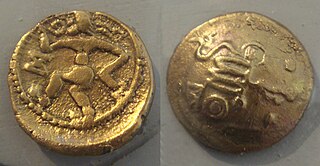
The Vellavii were a Gallic tribe dwelling around the modern city of Le Puy-en-Velay, in the region of the Auvergne, during the Iron Age and the Roman period.
The Reii were a Celto-Ligurian tribe dwelling in the modern department of Alpes-de-Haute-Provence during the Iron Age and the Roman period.

The Petrocorii were a Gallic tribe dwelling in the present-day Périgord region, between the Dordogne and Vézère rivers, during the Iron Age and the Roman period.

The Santoni or Santones were a Gallic tribe dwelling in the later region of Saintonge during the Iron Age and the Roman period.

The Eburovīcēs or Aulercī Eburovīcēs were a Gallic tribe dwelling in the modern Eure department during the Iron Age and the Roman period. They were part of the Aulerci.
The Seduni were a Gallic tribe dwelling in the upper Rhône valley, around present-day Sion, during the Iron Age and the Roman period.

The Redones or Riedones were a Gallic tribe dwelling in the eastern part of the Brittany peninsula during the Iron age and subsequent Roman conquest of Gaul. Their capital was at Condate, the site of modern day Rennes.

The Bituriges Vivisci were a Gallic tribe dwelling near modern-day Bordeaux during the Roman period. They had a homonym tribe, the Bituriges Cubi in the Berry region, which could indicate a common origin, although there is no direct of evidence of this.
The Caturiges were a Gallic tribe dwelling in the upper Durance valley, around present-day towns of Chorges and Embrun, during the Iron Age and the Roman period.

The Gabali were a Gallic tribe dwelling in the later Gévaudan region during the Iron Age and the Roman period.

The Namnetes were a Gallic tribe dwelling near the modern city of Nantes during the Iron Age and the Roman period.

The Segusiavī were a Gallic tribe dwelling around the modern city of Feurs (Auvergne-Rhône-Alpes) during the Iron Age and the Roman period.

The Tarbelli were an Aquitani tribe dwelling in the present-day regions of Labourd and Chalosse, in the west of Aquitania, during the Iron Age.

The Cocosates or Cocosates Sexsignani were an Aquitani tribe dwelling in present-day Landes during the Iron Age.

The Sotiates were a Gallic-Aquitani tribe dwelling in the region surrounding the modern town of Sos (Lot-et-Garonne) during the Iron Age and the Roman period.

The Auscii or Ausci were an Aquitani tribe dwelling around present-day Auch during the Iron Age.

The Bigerriones or Begerri were an Aquitani tribe dwelling in present-day Bigorre during the Iron Age.

The Cadurci were a Gallic tribe dwelling in the later region of Quercy during the Iron Age and the Roman period.

The Nitiobroges were a Gallic tribe dwelling on the middle Garonne river, around their chief town Aginnon, during Iron Age and the Roman period.
The Quariates or Quadiates were a Gallic tribe dwelling in the valley of Queyras, in the Alps, during the Iron Age.








